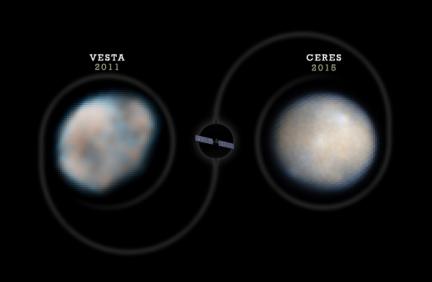The Dawn mission to the 2 largest asteroids in our Solar System was supposed to have been launched this week, but has been postponed until September of this same year. Apparently due to Dawn’s repeated launching schedule delays it could have interrupted the launching schedule for the Mars Pheonix lander which has a less flexible launch window.

The above images are the best taken thus far of both objects by the Hubble Space Telescope (images not to scale). Vesta appears to be similar to most objects of its type with one exception... We most likely have samples of this body here on Earth as meteorites. It seems the composition of a bunch of meteors known as HED class meteors match that of observations made of Vesta. The theory is that at some point a huge impact took place on Vesta which shattered it into many fragments. Some of these Vesta originating fragments are orbiting the sun in the Asteroid belt to this day while smaller bits of this collision were thrown inward toward the sun (likely through disturbances coming from Jupiter) and some wound up landing here on Earth as meteors. If this turns out to be true, then Vesta would be one of only 5 bodies that we currently have confirmed samples of. Those additional bodies being our own moon, Mars (also through a similar natural meteoric process), Wild 2 and Earth itself.
Ceres on the other hand is the largest Asteroid in the Solar System and for a few days was considered a planet in 2006 until the definition of “planet” was fine tuned a few days later to exclude not only Ceres, but famously Pluto as well. However, an upgrade was in order and Ceres is now officially a Dwarf Planet as it maintains its own spherical shape, orbits the Sun and is not itself a moon of any other body. More interesting than its definitive status in the Solar System is the fact that it is relatively warm, may have a tenuous atmosphere and frost on the surface. Some surface features have also raised many questions about the nature of Ceres such as the dark spot that was imaged in 95 and later disappeared. Then there is the recently observed white spot which has no theoretical identity at all. Hopefully, this may mean that in 2015 we may discover that Ceres is not just another heavily cratered inactive grey body in our Solar System but another enigmatic body like Io and Enceladus that defies preconceived notions of what to expect. Who knows what processes might cause Ceres to be active on any level, but surely we have been surprised before.